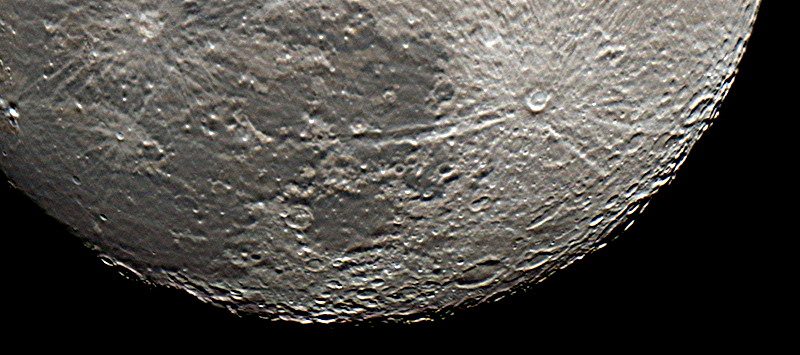
Moon in Relief; Spectroscopy Drift Imaging Test
Posted: 30 August 2012
Cassiopeia Observatory was opened Wednesday, 29 August 2012, at 2026 MST, 85°F. The sky was mostly clear with some cloud cover in the southwest. At 2032 MST, viewed the moon, 77X and 206X. Seeing was not very good. I did a short tour along the thin terminator region. I then switched to the visual back and mounted the D7000 DSLR at prime focus of the 8" LX200-ACF. This image, 1/250sec, ISO 100, was cropped to show just the terminator region:

As I was doing final processing on the above image, I accidently made an interesting image that seems to show exaggerated relief on the moon. With "unsharp mask" at a very high setting, this view of the moon appeared:

After I completed lunar imaging, I switched back to the star diagonal to do some spectroscopy tests with the "Star Analyzer". Leon Palmer at Rigel Systems had suggested I try using a "drift technique" to capture cleaner spectra. In the past, I had done short exposures (i.e., 1/10sec to 1/30sec) at high ISO (i.e., 1000, 1600, 2000) to acquire the spectrum of stars. This resulted in digital noise also being captured in the images. When processing these images, it was difficult to determine which "lines" were real "Fraunhofer Lines" and which were artifacts of the digital noise. So, this night I did some drift spectrum imaging.
I mounted the D7000 DSLR with the Star Analyzer at prime focus. I slewed the telescope to the star Deneb (spectral type A2) and rotated the camera body until the spectrum seen in the viewfinder was parallel to the Declination axis. I checked the orientation by watching the image in the viewfinder and slewing up and down in Declination. Once I had the camera orientation correct (or as correct as I could visually detect), I did a focus test image using the Bahtinov Mask. I then did 5 second exposures at various ISO settings. An ISO of 200 worked best. To accomplish the drift I would toggle the AutoStar "TARGETS: ASTRONOMICAL" setting to "TARGETS: TERRESTRIAL". That would turn off the Right Ascension drive and so the stars would drift during the exposure. This is the unprocessed image, 5 seconds, ISO 200:

During post-processing, I rotated the above image to make the drift movement vertical in the image:

The spectrum was then cropped and enlarged:

Some Fraunhofer Lines are visible in the image, especially in the blue end of the spectrum.
I then compressed the vertical axis to 1 pixel and expanded it back to 30 pixeds (as recommended in the Star Analyzer manual):
![]()
Compare the above image to this spectrum of Deneb I had captured 12 October 2011 at 1/25sec, ISO 1600:
![]()
The drift spectrum appears to be cleaner, with less digital noise and so less artificial lines. I will start re-imaging spectra that are shown on my Spectroscopy Photo Album.
The observatory was closed at 2124 MST, 79°F.
Raymond Gilchrist tweeted me a link to an excellent and free PDF called "Spectroscopic Atlas for Amateur Astronomers", subtitled "A Guide to the Stellar Spectral Classes". He also sent me this link: " David's Astronomy Pages: Spectroscopy". Thanks Ray! You can see Ray's spectroscopy on his web site.
Comments are welcome; use the Comments section below, or you can Email Me. Thanks.
Go to the previous report.
Return to the Cassiopeia Observatory Welcome Page.